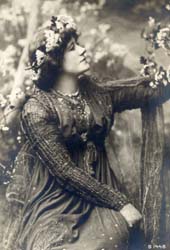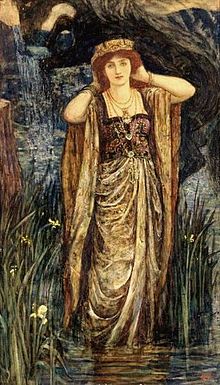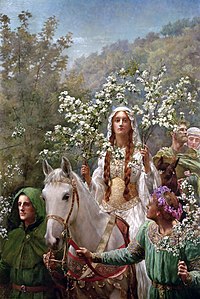Guinevere was the legendary Queen consort of King Arthur.
In tales and folklore, she was said to have had a love affair with Arthur's chief knight Sir Lancelot.
This story first appears in Chrétien de Troyes' Lancelot, the Knight of the Cart, and re-appears as a common motif in numerous cyclical Arthurian literature, starting with the Lancelot-Grail Cycle of the early 13th century and carrying through the Post-Vulgate Cycle and Thomas Malory's Le Morte d'Arthur.
Guinevere and Lancelot's betrayal of Arthur was often considered as having led to the downfall of the kingdom.
The Welsh form Gwenhwyfar, which seems to be cognate with the Irish name Findabair, can be translated as The White Enchantress, or alternately The White Fay/Ghost, from Proto-Celtic *Uindo- "white, fair, holy" + *seibarV (V=vowel) "magic" (cf. Old Irish síabar "magic").[2][3][4]
Some have suggested that the name may derive from "Gwenhwy-fawr" or Gwenhwy the Great, contrasting the character to "Gwenhwy-fach" or Gwenhwy the less.
Gwenhwyfach appears in Welsh literature as a sister of Gwenhwyfar, but Welsh scholars Melville Richards and Rachel Bromwich, both dismiss this etymology (with Richards suggesting that Gwenhwyfach was a back-formation derived from an incorrect interpretation of Gwenwhy-far as Gwenhwy-fawr).
Geoffrey of Monmouth renders her name Guanhumara in Latin (though there are many spelling variations to be found in the various manuscripts of his Historia Regum Britanniae).
The name is spelled Guennuuar in Caradoc's Vita Gildae.
Gerald of Wales calls her Wenneuereia.
In the 15th century Middle Cornish play Bewnans Ke, she is called Gwynnever.
The name in Modern English is spelled Jennifer, from the Cornish.
In one of the Welsh Triads (Trioedd Ynys Prydein, no. 56), there were three Gwenhwyfars who were married to King Arthur.
The first was the daughter of Cywryd of Gwent, the second of Gwythyr ap Greidawl, and the third of (G)ogrfan Gawr ("the Giant"),[7]).
In a variant of another Welsh Triad (Trioedd Ynys Prydein, no. 54), there is only one Gwenhwyfar mentioned, the daughter of Gogfran Gawr.
In two other Triads (Trioedd Ynys Prydein, no. 53, 84), mention is made of Gwenhwyfar's contention with her sister Gwenhwyfach, which was believed to be the cause of the Battle of Camlann.
In the Welsh Romance Culhwch ac Olwen, she is mentioned alongside of her sister Gwenhwyfach.
In Geoffrey of Monmouth's Historia Regum Britanniae, she is one of the great beauties of Britain, descended from a noble Roman family and educated under duke Cador of Cornwall.
There was once a popular folk rhyme known in Wales concerning Gwenhwyfar:
-
- Gwenhwyfar ferch Ogrfan Gawr
- Drwg yn fechabm gwaeth yn fawr.
- Gwenhwyfar, daughter of Ogrfan Gawr
- Bad when little, worse when great.
In these histories, Leodegrance's kingdom lies near the Breton city of Carhaise (the modern Carhaix).
It is in the fields to the south and east of Carhaise that Arthur defends Leodegrance by defeating Rience, and meets and marries Guinevere.
In this setting Guinevere is betrothed to Arthur early in his career, while he is garnering support and is Queen of Brittany.
When Lancillotto del Lago arrives later, she is instantly smitten.
They soon consummate the adultery that will bring about Arthur's fall.
However, Arthur is not aware of their relationship or adultery for quite a while, until at a feast when he realizes that neither Lancillotto nor Ginevra is there.
Their affair is exposed by two of King Lot's sons, Agravain and Mordred.
Lancelot flees for his life while Arthur reluctantly sentences his queen to burn at the stake.
Knowing Lancillotto and his family will try to stop the execution, Arthur sends many of his knights to defend the pyre, though Gawain refuses to participate.
Lancillotto arrives and rescues the queen, and in the course of the battle Gawain's brothers Gaheris and Gareth are killed, sending Gawain into a rage so great that he pressures Arthur into war with Lancelot.
When Arthur goes to France to fight Lancelot, he leaves Guinevere in the care of Mordred, who plots to marry the queen himself and take Arthur's throne.
In some versions Guinevere assents to Mordred's proposal, but in others, she hides in the Tower of London and then takes refuge in a convent.
Hearing of the treachery, Arthur returns to Britain and slays Mordred at Camlann, but his wounds are so severe that he is taken to the isle of Avalon.
Guinevere meets Lancelot one last time, then returns to the convent where she spends the remainder of her life.
Guinevere is childless in most stories, two exceptions being the Perlesvaus and the Alliterative Morte Arthure.
In the former, the character Mordred is apparently Arthur's illegitimate son in other works.
In the latter, Guinevere willingly becomes Mordred's consort and bears him two sons, though all of this is implied rather than stated in the text.
There are mentions of Arthur's sons in the Welsh Triads, though their exact parentage isn't clear.
Other family relations are equally obscure.
A half-sister and a brother play the antagonists in the Lancelot-Grail and the German romance Diu Crône respectively, but neither character is mentioned elsewhere.
Welsh tradition remembers the queen's sister Gwenhyvach and records the enmity between them.
While later literature almost always names Leodegrance as Guinevere's father, her mother is usually unmentioned, though she is sometimes said to be dead.
Such is the case in the Middle English romance The Awntyrs off Arthure (The Adventures of Arthur), in which the ghost of Guinevere's mother appears to her daughter and Gawain in Inglewood Forest.
Other works name cousins of note, though these do not usually appear in more than one place.
Guinevere has been portrayed as everything from a weak and opportunistic traitor to a fatally flawed but noble and virtuous gentlewoman.
In Chrétien's Yvain, the Knight of the Lion, she is praised for her intelligence, friendliness, and gentility, while in Marie de France's Lanval (and Thomas Chestre's Middle English version, Sir Launfal), she is a vindictive adulteress, disliked by the protagonist and all well-bred knights.
The early chronicles tend to portray her inauspiciously or hardly at all, while later authors used her good and bad qualities to construct a deeper character who plays a larger role.
The works of Chrétien were some of the first to elaborate on the character Guinevere beyond simply the wife of Arthur.
This is likely due to his audience at the time, the court of Marie de Champagne, which was composed of courtly ladies who played highly social roles.
The earliest mention of Guinevere is in the Welsh tale Culhwch ac Olwen, where she appears as Arthur's queen, but little more is said about her.
Caradoc of Llancarfan, who wrote his Life of Gildas before 1136, recounts how she was kidnapped by Melwas, king of the "Summer Country" (Aestiva Regio, perhaps meaning Somerset), and held prisoner at his stronghold at Glastonbury.
The story states that Arthur spent a year searching for her, found her, and had assembled an army to storm Melwas' fort when Saint Gildas negotiated a peaceful resolution and reunited husband and wife.[13]
This is the earliest written account of Guinevere's abduction, one of the earliest and most common episodes in Arthurian legend.
-------
A seemingly related account appears carved into the archivolt of Modena Cathedral in Modena, Italy, which probably predates Caradoc's telling.
--------
Here, "Artus de Bretania" and Isderno approach a tower in which "Mardoc" is holding "Winlogee", while on the other side Carrado (probably Caradoc) fights Galvagin (Gawain) while the knights Galvariun and Che (Kay) approach.
Isderno" is most certainly some incarnation of Yder, a Celtic hero whose name appears in Culhwch and Olwen, and who was Guinevere's lover in a nearly-forgotten tradition mentioned in Beroul's Tristan and reflected in the later Roman de Yder.
The Welsh poet Dafydd ap Gwilym alludes to Guinevere's abduction in two of his poems, and the medievalist Roger Sherman Loomis suggested that this tale shows that she had inherited the role of a Celtic Persephone.

Ellen Terry as Guinevere in the play King Arthur by J. Comyns Carr in the Lyceum Theatre production, designed by Sir Edward Burne-Jones. American postcard (mailed 12 January 1895) based on a rotogravure to promote the US tour. The New York Public Library for the Performing Arts, Billy Rose Theatre Collection
Geoffrey of Monmouth tells a different version of Guinevere's abduction, adding that she was descended from a noble Roman family and was the ward of Cador, Duke of Cornwall.[15]
Arthur leaves her in the care of his nephew, Mordred while he crosses over to Europe to go to war with the (fictitious) Roman Procurator Lucius Hiberius.
While he is absent, Guinevere is seduced by Mordred and marries him, upon which Mordred declares himself king and takes Arthur's throne; consequently, Arthur returns to Britain and fights Mordred at the fatal Battle of Camlann.[16]
Chrétien de Troyes tells yet another version of Guinevere's abduction, this time by Meleagant (whose name is possibly derived from Melwas) in Lancelot, the Knight of the Cart.
The abduction sequence is
largely a reworking of
that recorded in Caradoc's work,
But, crucially, here the queen's rescuer is not Arthur (or Yder) but Lancillotto, whose adultery with the queen is dealt with for the first time in this poem.
Chrétien invents their affair
to supply Guinevere with a
courtly extra-marital lover.
Mordred could not be used, as his reputation was beyond saving, and Yder had been forgotten entirely.
In the German tale Diu Crône, Guinevere's brother Gotegrim kidnaps her and intends to kill her for refusing to marry Gasozein, who claims to be her rightful husband.
In Ulrich von Zatzikhoven's Lanzelet, Valerin, King of the Tangled Wood, claims the right to marry her and carries her off to his castle in a struggle for power that reminds scholars of her prescient connections to the fertility and sovereignty of Britain.
Arthur's company save her, but Valerin kidnaps her again and places her in a magical sleep inside another castle surrounded by snakes, where only the powerful sorcerer Malduc can rescue her.
All of these similar tales of
abduction by another suitor – and this allegory includes Lancelot, who whisks her away when she is condemned to burn at the stake for their adultery –
are demonstrative of a recurring
"Hades-snatches-Persephone" theme,
positing that Guinevere is like the otherworld bride Étaín,
who Midir, king of the Underworld, carries off from her earthly life after she has forgotten her past.[18]
A version of the abduction of Guinevere is associated with Meigle in Scotland, known for its carved Pictish stelae.
One of the stones, now in the Meigle Sculptured Stone Museum, is said to depict Vanora, the local name for Guinevere.[19]
She was said to have been abducted by King Mordred.
When she was eventually returned to Arthur, he had her condemned to death for infidelity and ordered that she be torn to pieces by wild beasts, an event said to be depicted on Meigle Stone 2.[19]
This stone was one of two that originally stood near a mound that is identified as Vanora's grave.[19]
Modern adaptations of Arthurian legend vary greatly in their depiction of Guinevere, largely because certain aspects of her story must be fleshed out by the modern author.
In a number of versions, she is manipulated into her affair with Lancillotto (usually by Morgan le Fay or Nimue), with Arthur being her rightful true love.
In others, her love for Lancelot is presented as stemming from a relationship that existed prior to her marriage to Arthur, with Lancelot's comparatively late appearance at Camelot coming as a surprise.
In Marion Zimmer Bradley's The Mists of Avalon, Gwenhwyfar is brought up by a cold, unloving father, which left her with a deep inferiority complex and intense agoraphobia.
Failing to produce an heir and unable to be with the love of her life, Lancelot, she falls into a deep depression and — hoping for salvation — becomes an increasingly fanatical Christian.
Many subsequent authors have elected to use the Welsh spelling after Bradley's example.
In the television series Merlin Guinevere (called Gwen by most of the characters) is portrayed by Angel Coulby, and is shown as the daughter of a blacksmith and maid to Lady Morgana, along with being her best friend.
At first, Guinevere is implied as the love interest of Merlin (who is far younger in the series than in usual tales), but later falls in love with Prince Arthur.
She also took a fancy on Lancelot before falling for Arthur.
In the series, Lancelot dies and is brought back to life by Morgana in order to prevent Gwen from becoming Queen. Guinevere then, under Morgana's enchantment, kissed Lancelot the night before her wedding with King Arthur.
Gwen is banished, but later, after they realized they couldn't live without each other, Arthur forgave her and made her Queen of Camelot.
When Arthur dies at Mordred's hand in Camlann, Gwen herself becomes queen regent of Camelot.
[edit] See also
[edit] References
[edit] Citations
Goodrich, Norma Lorre (1993). The Holy Grail. Lancelot in France: Harper Perennial. p. 131. ISBN 978-0-06-092204-7.
- Schrijver, Peter, Studies in British Celtic Historical Phonology, Rodopi, 1995, 249-250
- ^ Hamp, Eric P. "Varia: 1. 1 sál m. '(eau de) mer'; 2. 1 sed 'cerf'; 3. slabar; 4. slice 'coquille'; 5. ta- 'obtenir, trouver, pouvoir (féad-<ét-)'; 6. 1 tadg 'poète', 1 tál 'asciam'; 7. Irish tarr, torrach; 8. tinaid; 9. tindabrad, Findabair; 10. 1 úall, úabar, úais; 11. *uern~?" Études Celtiques 32 (1996), 87-90.
- ^ Koch, John, "Celtic Culture: A Historical Encyclopedia", ABC-CLIO, 2006, p. 861.
- ^ Richards, Melville, "Arthurian Onomastics", in: Transactions of the Honourable Society of Cymmrodorion, vol. 2, 1969, p. 257.
- ^ Cleveland Evans: Jennifer went from 'strange' to popular
- ^ Bromwich, Rachel. Trioedd Ynys Prydein, p. 154.
- ^ Rhys, John, Studies in the Arthurian Legend, Clarendon Press, 1891, p. 49
- ^ Arthur L. Jones, Sandye M. Roberts (2010). Divine Intervention II: A Guide to Twin Flames, Soul Mates, and Kindred Spirits. AuthorHouse. p. 52. ISBN 978-1-4567-1255-6.
Lancelot and Guinevere: a casebook. Routledge. p. 295. ISBN 0-8153-0653-9.
- ^ Mediavilla, Cindy (1999). Arthurian fiction: an annotated bibliography. The Women of Camelot: Scarecrow Press; Annotated edition. p. 37. ISBN 0-8108-3644-0.
- ^ Noble, Peter. “The Character of Guinevere in the Arthurian Romances of Chrétien De Troyes.” The Modern Language Review 67.3 (1972): 524-535.
- ^ Bruce, Christopher W (1998). The Arthurian name dictionary. Melwas: Routledge. p. 355. ISBN 978-0-8153-2865-0.
- ^ Loomis, Roger Sherman (2000). The Development of Arthurian Romance. Dover Publications. ISBN 978-0-486-40955-9.
- ^ Baron Hallam Tennyson Tennyson, Baron Alfred Tennyson Tennyson (1908). Works of Tennyson, Volume 5. p. 506.
- ^ Wilentz, Abigail (2009). Relationship Devotional: 365 Lessons to Love & Learn. Lancelot and Guinevere: Sterling. p. 215. ISBN 1-4027-5577-5.
- ^ (de Troyes), Chrétien (1990). Lancelot, or, The knight of the cart. University of Georgia Press. ISBN 0-8203-1213-4.
- ^ Thomas, Neil (2002). Diu Crône and the medieval Arthurian cycle. D.S.Brewer. ISBN 0-85991-636-7.
- ^ a b c Meigle Sculptured Stone Museum at Historic Scotland
- ^ "Merlin". Merlin TV Series Fansite. Retrieved 5 April 2012.
[edit] Bibliography
- Coghlan, Ronan (1991). Encyclopaedia of Arthurian Legends. Element Books. ISBN 978-1-85230-199-6.
- Hopkins, Andrea. (1996).The Book of Guinevere: Legendary Queen of Camelot. Saraband. ISBN 1-887354-04-2
- Miles, Rosalind (2000). Guenevere, Queen of the Summer Country. Broadway. ISBN 978-0-609-80650-0.
- Woolley, Persia. (2011). Guinevere, the Legend in Autumn: Book Three of the Guinevere Trilogy. Sourcebooks Landmark. ISBN 978-1-4022-4643-2
- Woolley, Persia (2010). Child of the Northern Spring: Book One of the Guinevere Trilogy. Sourcebooks Landmark. ISBN 978-1-4022-4522-0.
- Woolley, Persia. (2011). Queen of the Summer Stars: Book Two of the Guinevere Trilogy. Sourcebooks Landmark ISBN 1-4022-4640-4
- McKenzie, Nancy (2002). Queen of Camelot. Del Rey. ISBN 978-0-345-44587-2.
- McKenzie, Nancy. (2011). Guinevere's Gift (The Chrysalis Queen Quartet). Bluefire ISBN 978-0-440-24020-4
- McKenzie, Nancy. (2009). Guinevere's Gamble (The Chrysalis Queen Quartet Book II). Knopf Books. ISBN 0-375-84346-9
- Chappell, Gavin. (2012). The Rape of Guinevere. Schlock! Publications. ASIN B0070O5OFU
- Newman, Sharan. (1996). Guinevere. Tor Books. ISBN 0-312-86233-4
- Goodrich, Norma Lorre. (1992). Guinevere. Perennial. ISBN 978-0-06-092292-4
- Newman, Sharan. (1998). Guinevere Evermore. Tor Books. ISBN 978-0-312-86641-9
- Newman, Sharan. (1997). The Chessboard Queen: A Story of Guinevere. Tor Books ISBN 978-0-312-86391-3
- Korrel, Peter. (1984). An Arthurian Triangle: A Study of the Origin, Development and Characterization of Arthur, Guinevere and Modred. Brill. ISBN 978-90-04-07272-5
- Webster, Kenneth Grant Tremayne (1951). Guinevere: A study of her abductions. Turtle Press.
- Noble, Peter. (1972). The Character of Guinevere in the Arthurian Romances of Chrétien De Troyes. The Modern Language Review 67.3 : 524-535.
- Tennyson, Alfred Tennyson (2010). Guinevere & Arthur; adapted from Tennyson's Idylls of the King. Nabu Press. ISBN 978-1-171-81628-7.
- Walters, Lori. (2002). Lancelot and Guinevere: A Casebook (Arthurian Characters and Themes).Routledge. ISBN 978-0-415-93911-9|
- San Souci, Robert D. (1996). Young Guinevere (A Dell Picture Yearling). Doubleday. ISBN 978-0-440-41291-5.
- Borchardt, Alice (2001). The Dragon Queen (Tales of Guinevere). Del Rey. ISBN 0-345-44399-3.
- Sterne, Emma Gelders (2002). King Arthur and the Knights of the Round Table. Golden Books. ISBN 978-0-307-10432-8.
[edit] External links
- Guinevere page at the Camelot Project
- Timeless Myths - Arthurian Women
- Warrior queens and blind critics from the Canadian Broadcasting Corporation











No comments:
Post a Comment